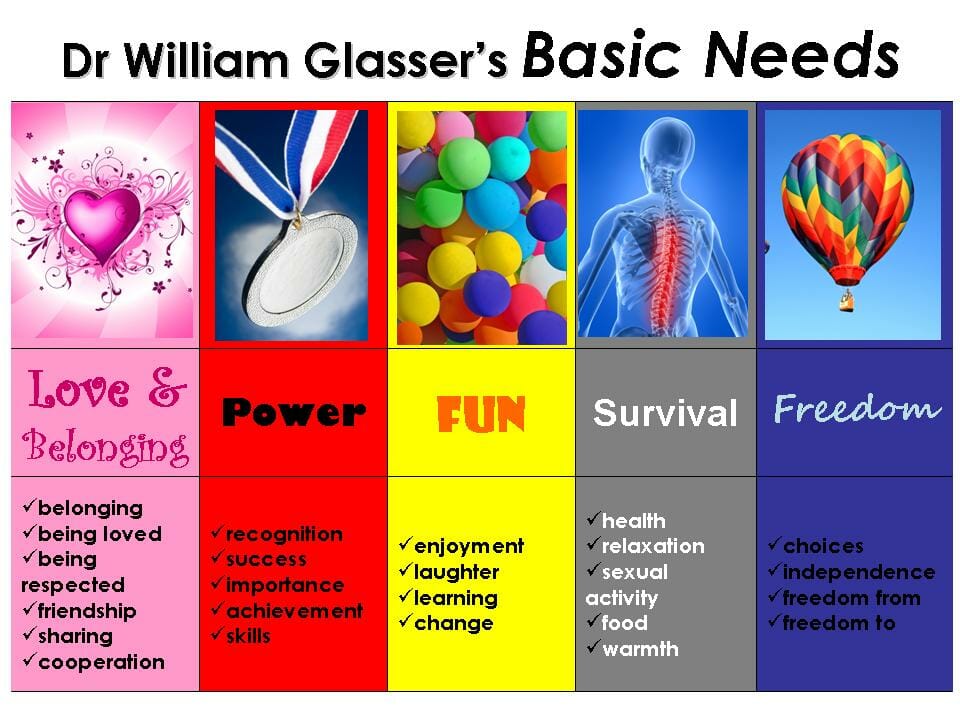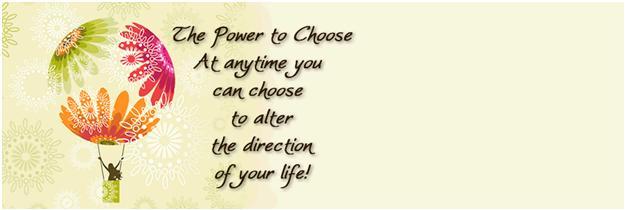
Dr. William Glasser is an American psychiatrist who developed the Reality Theory, which later on became known as the Choice Theory. In the seventies, Glasser’s work was not highly accepted by his colleagues.
While others thought that human behavior is affected by external sources, Glasser believed in personal choice, personal responsibility, and personal transformation. While others considered certain behaviors as mental disorders and prescribed medication for these, Glasser believed in the education and empowerment of his clients to change their choices.
He applied his theories on education, management, and marriage.
The Choice Theory states that a person’s behavior is inspired by what that person wants or needs at that particular time, not an outside stimulus. Glasser thought all living creatures control their behavior to fulfill their need for satisfaction in one or more of these five areas:
- Need for survival
- Need to belong and be loved by others
- Need for power and importance
- Need for freedom and independence
- Need to have fun
As you can see, those are not desires. Rather, they are needs. A need is a strong desire we can’t live without. It is not a preference. It is not a want (many times it is subconscious and we are not even aware of it). It is something that is so strong that it functions as a prerequisite for our emotional functions.
Based on Glasser, every person has the power to change their lives based on the choices they make.
Working the Muscle of Choice

When I first studied Glasser during my education degree, I thought I had found gold and made a choice to use his methods in my teaching. I discovered that when my students learned to make choices and I treat them as muscles—that the more you use them, the better they were—it really becomes true.
My choice to use this theory in such an early stage in my career brought me lots of success and positive experiences. As you know, success breeds success, and I have made a choice to go with what works and was able to change my life based on those choices.
Similar to Glasser, who worked with people who were mentally ill (or perceived to be mentally ill), I worked with kids that were labelled intellectually disabled, emotionally disabled, and had learning disabilities. The education and special education world spent years discussing the terminology.
I was very happy when they changed the term “learning disabilities” to “learning difficulties”. I proved (first to myself) while helping my students work the muscle of choice, that the only difficulty they really had was living in an “autistic” society or close-minded education system, which had difficulties accepting that some kids just learn differently, but not necessarily in an inferior way.
Many of them had unique learning abilities. When these kids recognized and appreciated their abilities and learning styles, they were amazingly gifted kids.
Glasser’s book, Choice Theory: A New Psychology of Personal Freedom (1998), was very new when I started my career, but it was very popular with my teachers and I thank them for it.
It is no coincidence that when I started Be Happy in LIFE, my consulting and life coaching business, I chose to teach my clients Choice Theory. As part of the Be Happy in LIFE coaching program for individuals, kids, parents, teachers and couples, strengthening the choice muscle was the ultimate solution to bringing sanity to life.
Glasser proved it years ago and I have proven it with all my clients. Every one of them is much better at making decisions and taking responsibility.
A Guide to a Happy Life
Based on Glasser, any person can make good choices by taking responsibility for their actions. He came up with a list of 4 questions that can be a guide to a happy life:
- What do you want?
- What are you doing to achieve what you want?
- Is it working?
- What are your plans or options?

I have used Glasser’s questions in my teaching and coaching for many years. My two published books, Be Special, Be Yourself for Teenagers and In the Outback with Jasmine Banks, discussed the choices we make as the compass in our life. When my husband Gal and I searched for a slogan for our coaching service, “Happiness is a choice!” summed it all.
It is amazing how life-changing the question “What do you want?” can be. My book, Reflections, focuses on the “wanting” muscle and how important it is in finding happiness, direction, and purpose in life.
When I conduct parenting workshops, people ask me how I get the information from the kids I coach.
Most of the time, I see kids for 3 one-hour sessions and learn very much about them. Their parents are shocked when I write a detailed report about their kids after seeing them for such a short time. I tell them that I ask! Just asking the kids give them an opportunity to strengthen the muscle.
Think of Glasser’s five needs again. I fulfill all their needs in a very short time and they are very happy in coming to see me. Their answers are a true reflection of what is happening inside of them. Everyone can do that.
The 5 Needs of Choice Theory

- The need to belong and be loved by others. I touch the kids I work with. I highlight their parents’ love and care for them and that this is the reason they brought them to see me.
- The need to have power and importance. I share with them my search for their uniqueness. I allow them to choose activities to give them a sense of control. I ask them what they want and what they think. There is so much to learn from answering these questions.
- The need for freedom and independence. When I give them an activity, I give them time and do not push them. Again, I give them choices and tell them they can do the activity any way they like.
- The need to have fun. Games were always the best learning tool!
Even my adult clients fill in a form before they come to see me and those questions are also in their client details. I learn so much from what they want.
Many theories have branched out from the choice theory, even theories I use myself, like the needs theory of American life coach Tony Robbins, “The Work” by American author Byron Katie, who wrote Loving What Is, neurolinguistic programming(NLP), and cognitive-behavioral therapy (CBT), to name a few.
I have found out that answering Glasser’s questions is a wonderful way to move forward with any problem we face. Try it! You’ll be surprised to discover how easy and powerful it is.
Join me next time as I explain the choice theory in relationships.
Happy choices,
Ronit












